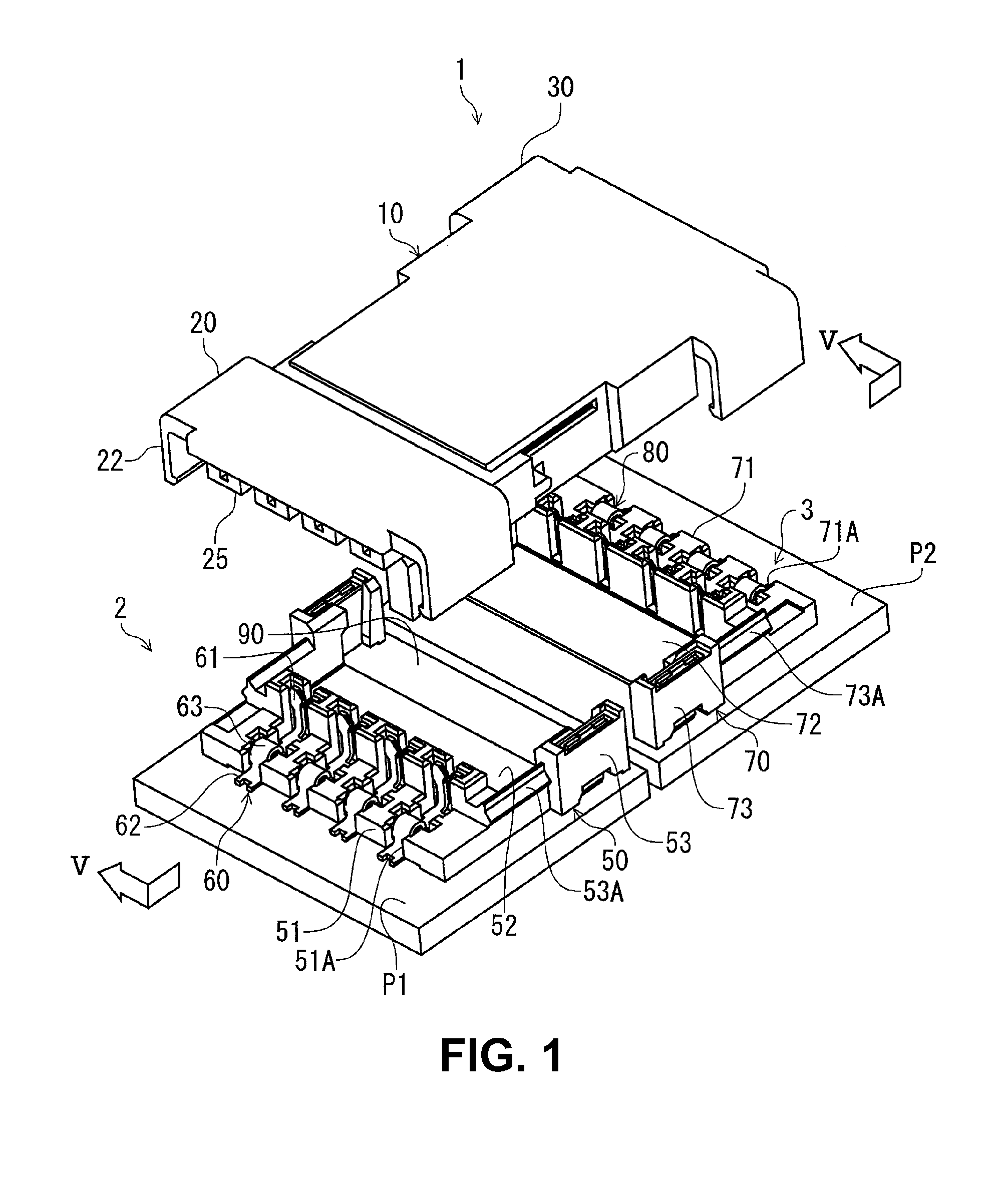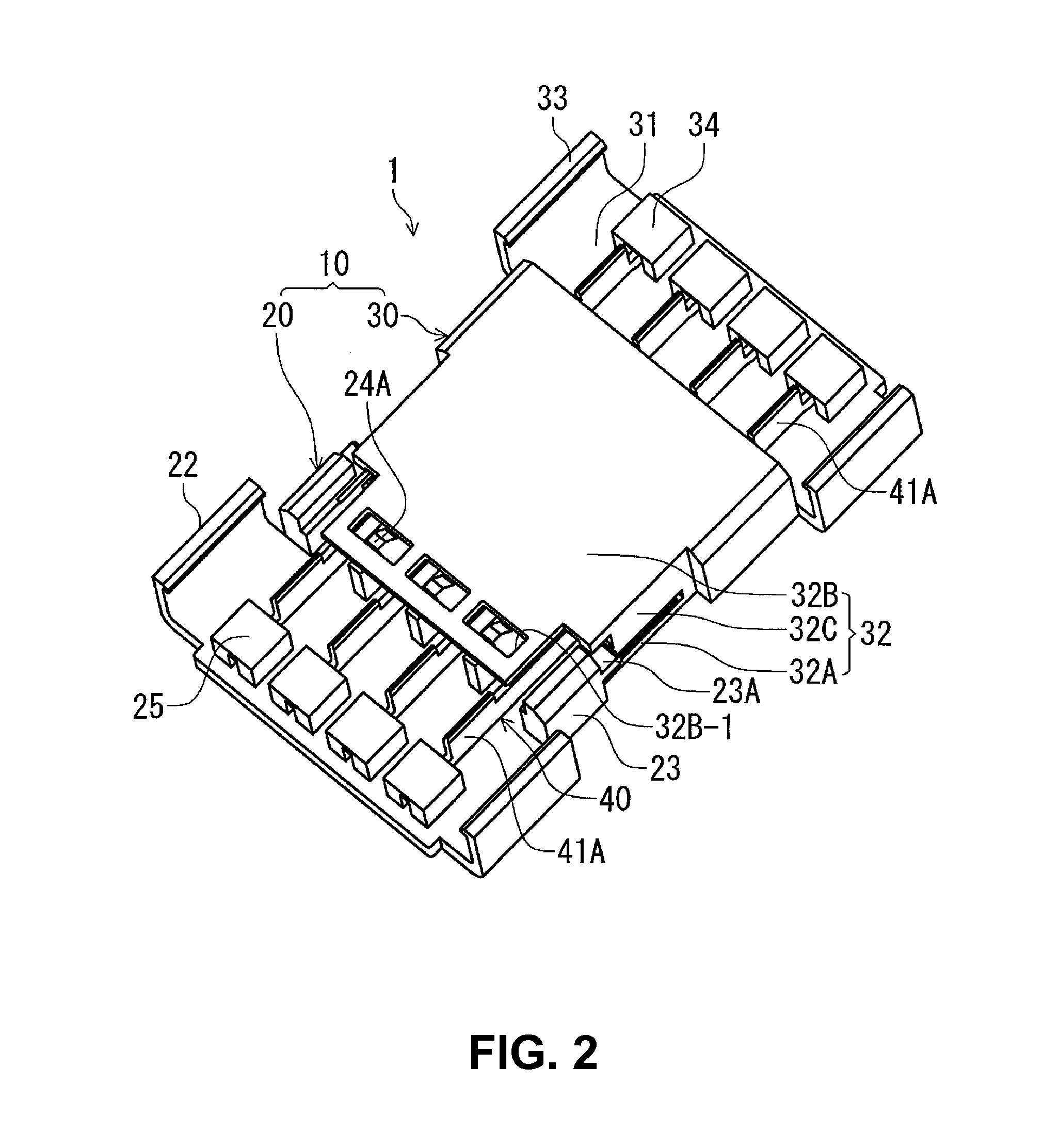Joining electrical connector
a technology of joining electrical connectors and connectors, which is applied in the direction of securing/insulating coupling contact members, coupling device connections, printed circuits, etc., can solve the problems of difficult to make the conventional joining electrical connectors with a lower profile, and achieve the effect of reducing the profile of the joining terminal and less resistan
- Summary
- Abstract
- Description
- Claims
- Application Information
AI Technical Summary
Benefits of technology
Problems solved by technology
Method used
Image
Examples
first embodiment
[0035]FIG. 1 is a perspective view of a joining electrical connector and board electrical connectors in the embodiment, and shows a state that is viewed from thereabove when the connectors are separated from each other. In addition, FIG. 2 is a perspective view of the joining electrical connector of FIG. 1, which is viewed from therebelow. A joining electrical connector 1 of the embodiment (hereinafter simply referred to as a joining connector 1) is fitted from thereabove to connect to the mating connectors, i.e. board electrical connectors 2 and 3 (hereinafter referred to as a board connector 2 and a board connector 3, respectively), which are respectively mounted on circuit boards P1 and P2 provided so as to have their edges face to each other on the same surface, and thereby connect the board connectors 2 and 3.
[0036]The joining connector 1 has a housing 10 that has a shape of a generally rectangular prism and is made of synthetic resin; and a plurality of joining terminals 40 (s...
second embodiment
[0092]FIG. 12 is a perspective view of a part of the joining terminal in the second embodiment. In the figure, parts that correspond to those in the first embodiment are indicated with reference numerals that are the numerals in the first embodiment plus “100”. The joining terminals 140 in the embodiment are different from the joining terminals 40 in the first embodiment, since there is a slit-like groove 141C formed to extend in the connector fitting direction between the contact section 141A and the joining section 141B, while there is no such groove formed and the joining section 41B is continuous to the contact section 41A over the whole range in the connector fitting direction in the first embodiment.
third embodiment
[0093]FIG. 13 is a perspective view of a part of the joining terminal in the third embodiment. In the figure, parts that correspond to those in the first embodiment are indicated with reference numerals that are the numerals in the first embodiment plus “200”. The joining terminals 240 in the embodiment are different from the joining terminals 40 in the first embodiment, since the extending section 242 is rolled so as to curl in the plate thickness direction, while the extending section 42 is formed to be a flat plate. In addition, the joining terminals 240 are different from the joining terminals 40 in the first embodiment since the lower end surface of each extending section 242 is flat, while there is the protrusion to be supported 42A formed to protrude from a lower end of each extending section 42.
[0094]The joining terminal 240 is supported by a support section (not illustrated) of the housing at a flat lower end surface of the extending section 242.
PUM
 Login to View More
Login to View More Abstract
Description
Claims
Application Information
 Login to View More
Login to View More - R&D
- Intellectual Property
- Life Sciences
- Materials
- Tech Scout
- Unparalleled Data Quality
- Higher Quality Content
- 60% Fewer Hallucinations
Browse by: Latest US Patents, China's latest patents, Technical Efficacy Thesaurus, Application Domain, Technology Topic, Popular Technical Reports.
© 2025 PatSnap. All rights reserved.Legal|Privacy policy|Modern Slavery Act Transparency Statement|Sitemap|About US| Contact US: help@patsnap.com



